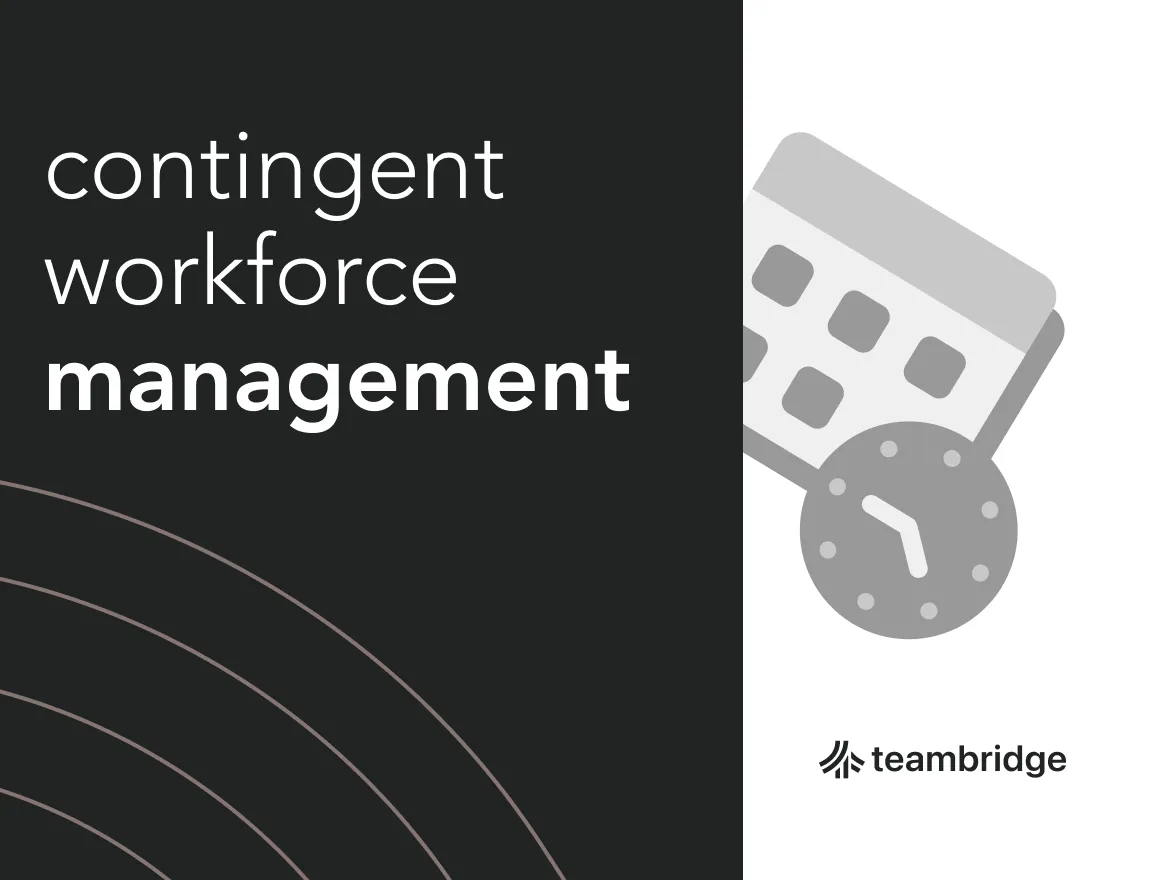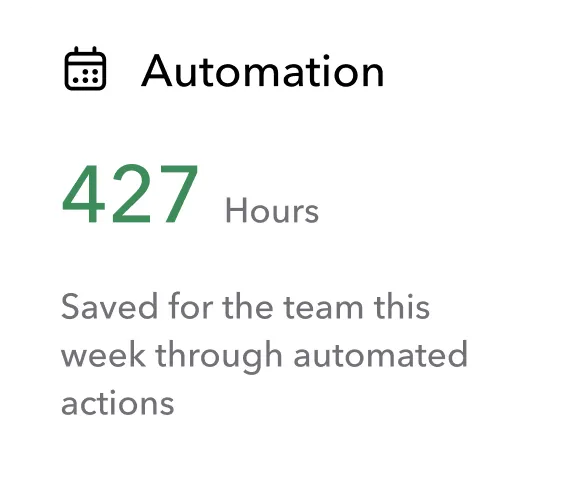Managing a contingent workforce shouldn’t feel like herding cats. Whether you’re staffing up across multiple locations, juggling last-minute shift changes, or staying ahead of compliance, every moving part needs to click into place fast. That’s where contingent workforce management (CWM) comes in. It’s precisely what Teambridge was built for.
With customizable scheduling, automated staffing, built-in time tracking, and a mobile-first experience, Teambridge makes it easy to coordinate large talent pools of flexible workers without the chaos. Dive into what CWM means, why it matters more than ever, and how the right platform turns CWM from a headache to your competitive edge.
What is contingent workforce management?
Contingent workforce management (CWM) refers to how organizations manage flexible, non-permanent workers, such as temps, independent contractors, freelancers, or gig workers. It includes everything from onboarding and scheduling to compliance, time tracking, and pay, ideally through a system that ensures these workflows run like clockwork.
Why contingent workforce management matters
Contingent workers now make up as much as 30–40% of the U.S. workforce, and the numbers keep climbing. Without the right systems in place, managing contingent workers can quickly spiral into disorganized scheduling, compliance headaches, and missed opportunities.
That’s why composable platforms like Teambridge are game changers. Just ask Revv Staffing. The healthcare staffing agency used Teambridge to coordinate its nurse workforce, slashing admin time by 60%, automating hundreds of hours of manual work per week, and growing revenue by 40%. Better tools make CWM more than manageable—they make it a significant growth driver.
Key benefits of an effective contingent workforce strategy
Having an effective contingent workforce management strategy in place improves the end-to-end employee experience, helping you retain top talent while reducing headaches across your organization.
Here are a few advantages you can expect to see :
- Cost savings at scale: According to recent data, 84% of companies experience cost savings with contingent workers because of reduced benefits and overhead expenses.
- Productivity boost: McKinsey estimates that contingent workers contribute roughly 15% of total workforce productivity, underscoring their impact on output and organizational goals.
- Flexibility to scale: Organizations can rapidly increase or decrease contingent labor in response to project needs or seasonal demand, maintaining agility and avoiding the burden of hiring and firing full-time employees.
- Talent access and trial: Working with contingent talent lets you tap into specialized skills quickly and test potential hires before making permanent commitments.
- Better visibility and control: Centralized systems reduce maverick spend, ensure consistent vendor rates, and standardize compliance, minimizing unexpected costs.
- Client and staff engagement gains: Express Healthcare saw a 21% increase in shift claims and a 19% lower churn rate after rolling out Teambridge. Even more telling: Clients using the Teambridge dashboards now allocate 35% more business to Express.
- Faster time-to-fill and onboarding: Automated workflows accelerate everything from candidate intake to first-day scheduling and time tracking, reducing delays and getting shifts filled faster.
Together, these benefits transform CWM from a reactive scramble into a strategic differentiator, unlocking growth and competitive advantage.
Common challenges in managing a contingent workforce
Contingent workforce management offers major benefits, but realizing them requires a solid foundation. Without it, things can rapidly break down. From compliance risks to visibility gaps, here are some of the most common pitfalls that hold organizations back:
- Visibility gaps: Without centralized oversight, hiring managers often work in silos, resulting in fragmented processes, inconsistent vendor usage, and budget leakage.
- Compliance and legal risk: Misclassifying contingent workers or skipping vetting steps can result in fines, lawsuits, and reputational damage.
- Cost control issues: A lack of enforcement around approved rates or processes leads to rogue or inflated spending, draining savings.
- Inconsistent performance monitoring: Fragmented onboarding and evaluation processes can hurt worker quality, engagement, and long‑term success.
- Operational inefficiency: Manual or disconnected systems slow staffing cycles and create an administrative burden across teams.
- Worker dissatisfaction: Poor experiences, like delayed pay or limited tools, lower morale and hurt retention among flexible staff.
- Risk of knowledge loss and continuity breaks: Without standardized onboarding and offboarding, organizations risk losing project context, critical training, and institutional memory.
The good news? Your organization can solve these challenges with the right tools and a strategy built for today’s dynamic workforce.
Top components of a successful contingent workforce management program
A strong contingent workforce strategy is about building the infrastructure to manage your workers well. These are the building blocks every high-performing CWM program needs:
- Centralized platform and vendor management systems (VMS): One system for sourcing, contracts, compliance, time‑tracking, and billing
- Automated staffing and scheduling tools: Smart matching, shift swaps, and scheduling automation to reduce manual busywork
- Mobile-first worker experience: Self-service onboarding, time sheets, job acceptance, and access to instant pay, all on the go
- Robust compliance features: Built‑in classification, document tracking, verifications, and policy enforcement
- Analytics and reporting dashboards: Real-time visibility into spend, performance, workforce utilization, and vendor effectiveness
- Integrated time and attendance tracking: Accurate hours capture, audit trails, and streamlined payroll integration
- Scalability and flexibility: Modular, architected tools that support multi-site operations and evolving business needs
Equipped with these essential components, your CWM program becomes a strategic advantage.
Implementing best practices for contingent workforce management
The most successful CWM programs don’t happen by accident—they’re built with intention. By aligning people, processes, and platforms from day one, organizations can scale intelligently, stay compliant, and keep their workforce thriving. Here’s how to do it right, one building block at a time:
Planning & goal setting
Before rolling your CWM strategy out to the entire organization, get clear on why you’re hiring and how you’ll manage it. Define what success looks like, whether that’s reducing time-to-fill, cutting overtime costs, or boosting fill rates across locations. Lean on workforce planning tools to forecast demand, align with business cycles, and flag gaps in capacity. From there, build a repeatable talent acquisition and hiring process that ensures you’re attracting the right people, for the right roles, at the right time.
Compliance & risk management
Missteps here can be costly. Ensure your program is grounded in a clear understanding of labor laws, worker classification rules, and documentation standards. Automate compliance checkpoints and document collection during onboarding to reduce the risk of errors, and make sure you can back it all up with an audit trail.
Multi-site scheduling & coordination
If you’re staffing across multiple worksites or clients, visibility is everything. Without centralized scheduling, it’s easy to double-book workers, overlook location-specific rules, or miss urgent needs. Use smart scheduling tools that provide managers with real-time oversight, enable shift swaps, and reduce the back-and-forth that slows everyone down.
Worker engagement & retention
Keeping your temporary workers happy is just as important as staffing them. Self-service tools, real-time communication, and quicker access to pay all contribute to higher work satisfaction and reduce turnover. Don’t underestimate the power of modern tech to make your contingent talent feel supported and seen.
Metrics & KPI frameworks
You can’t improve what you can’t measure. Build a dashboard of key metrics—like time-to-fill, shift fill rate, worker satisfaction, and cost per hire—and track progress over time. That visibility helps your team identify bottlenecks, prove ROI, and continually optimize performance.
Essential capabilities for contingent workforce management software
Managing a modern, flexible workforce takes more than spreadsheets and good intentions. The right CWM platform gives you the tools to scale with confidence, particularly one with built-in adaptability. That’s why customization and extensibility are key: No two organizations manage their talent pool the same way, and your software should adapt to your workflow.
Here are must-have capabilities for today’s CWM software:
- Automated scheduling & dispatch: Enable on-demand placements and auto-fill shifts with the appropriate available workers based on availability, preferences, or past performance.
- Compliance tracking & audit trails: Stay ahead of audits and misclassification risks with automated document collection, classification logic, and historical logs.
- Cost control & budgeting tools: Monitor spend by location, role, or client. Set rate limits, automate approvals, and flag overages before they become problems.
- Automated onboarding & time-tracking: Get workers set up in minutes, not days. Collect required documents, assign training, and track hours in real-time with mobile-first tools.
- Analytics & reporting dashboards: Pull insights across teams, locations, and programs to guide smarter decisions, track progress, and optimize operations.
In recent years, the organizations thriving with contingent talent aren’t just the ones hiring quickly; they’re the ones investing in systems that scale, flex, and grow with them. Teambridge delivers these essential capabilities for your business.
Future trends & innovations in contingent workforce management
Most guides stop at CWM processes and often overlook how technology is shaping the future of contingent workforce management. From AI workforce management tools that predict staffing needs to blockchain-based credentials that verify worker qualifications in seconds, innovation is redefining what’s possible.
And organizations are taking notice. According to a recent Deloitte survey, 60% of companies using contingent labor are already incorporating AI and machine learning to streamline decision-making and optimize workforce operations. Meanwhile, the gig economy continues its upward climb, on track to represent half of the U.S. workforce by 2028. To stay competitive, businesses need systems that are flexible, intelligent, and built for scale.
Teambridge gives you exactly that. Whether you're managing ten shifts or ten thousand, the Teambridge platform helps you reduce contingent labor costs, increase visibility, and move faster, all without compromising control. Request your personalized demo today and see what a modern CWM platform can do for your operations.
Frequently asked questions about CWM
What is an example of a contingent worker?
A contingent worker is someone hired on a non-permanent basis, like a temp, contractor, freelancer, or gig worker, often for a specific project or time period.
What are the drawbacks of hiring contingent workers?
Without the right systems in place, contingent labor can introduce compliance risks, inconsistent performance, and scheduling inefficiencies. That’s why streamlined management is key.
What is contingent worker management?
Contingent workforce management is the process of onboarding, organizing, scheduling, and overseeing non-permanent staff, often using software to automate tasks, track compliance, and scale operations efficiently.











